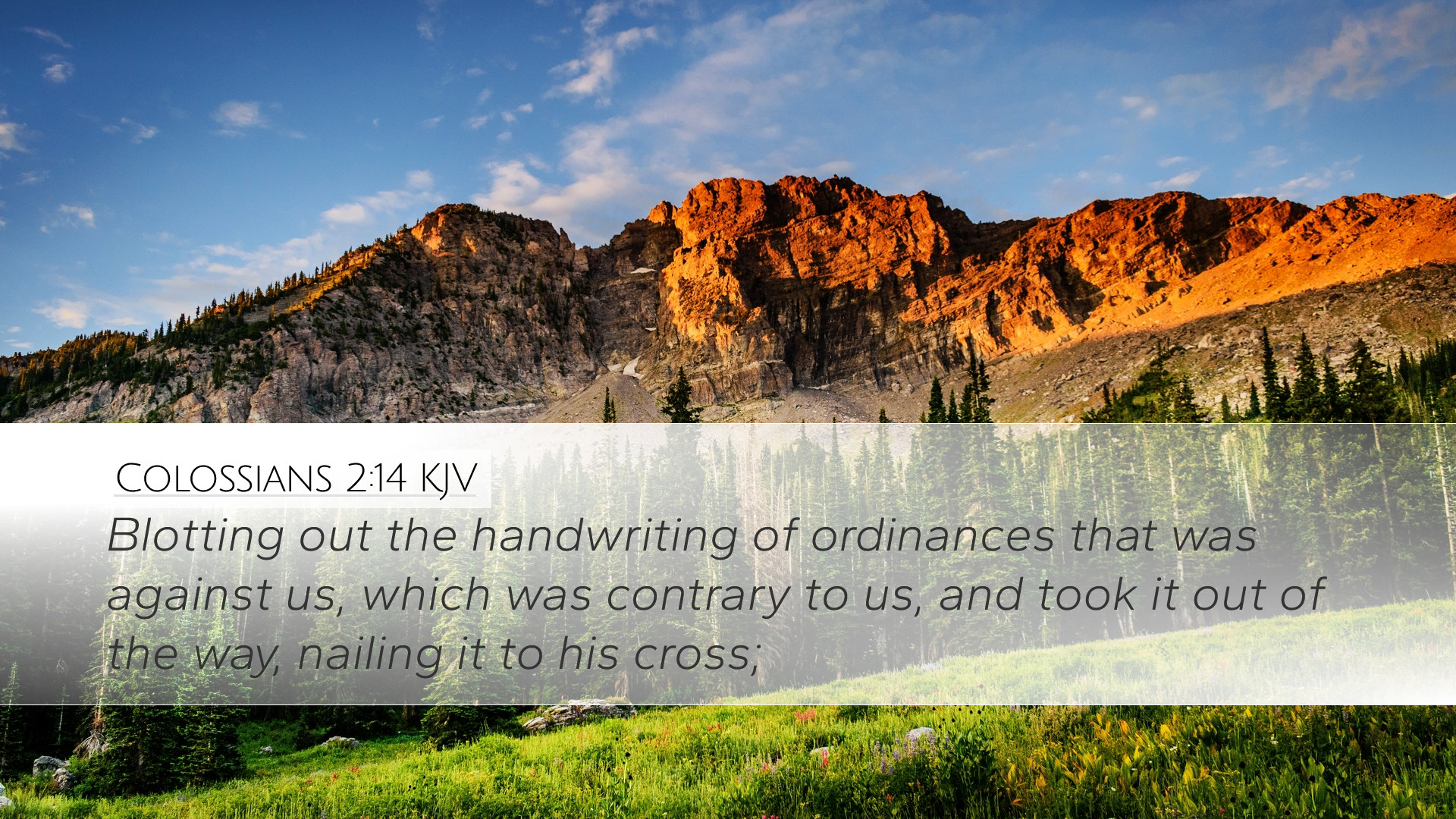Commentary on Colossians 2:14
Colossians 2:14 (KJV): "Blotting out the handwriting of ordinances that was against us, which was contrary to us, and took it out of the way, nailing it to his cross."
Introduction
The apostle Paul, in his letter to the Colossians, addresses a crucial element of the Christian faith: the work of Christ on the cross and its implications for the law and the ordinances that were once binding upon humanity. This particular verse encapsulates the transformative power of the cross, suggesting a shift from the old covenant to the new covenant in Christ.
Overview of the Verse
Colossians 2:14 presents a pivotal theological insight: the cancellation of the "handwriting of ordinances" that stood opposed to believers. This doctrine holds profound significance for understanding Christ’s atonement and the believer's relationship to the law.
Historical Context
During the time of Paul's writing, the early church faced opposition from various groups, including Judaizers who emphasized the necessity of adhering to the Mosaic Law. Paul counters this by affirming that Christ's sacrifice has fulfilled the law, liberating believers from its stringent demands.
Insight from Public Domain Commentaries
Matthew Henry’s Commentary
Nature of the "Handwriting": According to Henry, the "handwriting of ordinances" refers to the ceremonial laws and requirements that were inscribed like a legal document against humanity because of sin. These ordinances acted as a witness to our guilt and the punishment we deserved.
Blotting Out: Henry elaborates that God, in His mercy, has "blotted out" this record, akin to how debts are erased. This act signifies not only the removal of condemnation but also the establishment of a new relationship between God and humanity through Christ.
Nailing to the Cross: The imagery of nailing the ordinances to the cross indicates a definitive act by which Christ has borne our sins and the accusations against us. This results in a complete removal of the charges that once held us captive, showcasing God's grace and love.
Albert Barnes’ Notes on the Bible
Examination of “Handwriting of Ordinances”: Barnes interprets the "handwriting" as the moral and ceremonial laws that were inscribed against us, highlighting their function as a barrier to salvation. He views these laws as serving to expose sin rather than forgive it.
The Role of Christ's Sacrifice: Barnes emphasizes that the act of Christ nailing these ordinances to the cross represents the abolition of the law's condemning power. By this means, believers are no longer slaves to the law, but free to live in the grace provided through Christ.
Implications for Believers: The author argues that this freedom signifies access to God without the burdens imposed by the law. It allows Christians to approach God with confidence, being justified through faith in Christ, not by works of the law.
Adam Clarke’s Commentary
Theological Significance: Clarke notes that the phrase "handwriting of ordinances" points to the written moral code and the rituals that characterized the old covenant. He asserts that these were intended to guide people but also served to reveal human failure.
Divine Forgiveness: Clarke stresses the importance of understanding that the removal of this handwriting is an act of profound divine mercy. He elaborates on the idea that God’s decision to nail these ordinances to the cross conveys His willingness to forgive the ungodly through the sacrifice of Jesus.
Transformation of Worship: He further indicates that with this transformation, worship is no longer confined to the temple practices of the law but is now an expression of genuine faith in Christ, free from the constraints of ritualistic observance.
Theological Implications
- Justification by Faith: The verse firmly establishes the principle of justification by faith, positing that believers are accepted by God through Christ's work rather than their adherence to the law.
- The New Covenant: It introduces the understanding of the New Covenant, where God's laws are written on the hearts of believers rather than merely adhered to externally (Jeremiah 31:33).
- Freedom from Condemnation: The removal of ordinances signifies that believers are no longer subject to the condemnation inherent in the law, reflecting the overarching theme of grace in the New Testament.
Practical Applications
- Encouragement in Trials: Believers are encouraged to trust in the sufficiency of Christ's sacrifice, understanding that no external ordinance can separate them from God’s love.
- Empowerment for Holy Living: Recognizing their freedom from the law allows believers to live empowered lives, guided by the Spirit rather than a set of rules.
- Promoting Unity: This understanding fosters unity within the church, as believers acknowledge that all have been granted equal access to grace, irrespective of their backgrounds.
Conclusion
Colossians 2:14 serves as a profound declaration of the power of Christ’s sacrificial love. In light of the insights offered by esteemed commentators like Matthew Henry, Albert Barnes, and Adam Clarke, we glean a deeper understanding of how this verse encapsulates the essence of Christian faith: liberation from the burden of the law through the grace found in Jesus. As pastors, students, theologians, and scholars reflect on this verse, may it inspire a commitment to living in the freedom and joy that comes from knowing our sins are forgiven, and our lives transformed through Christ's work on the cross.


